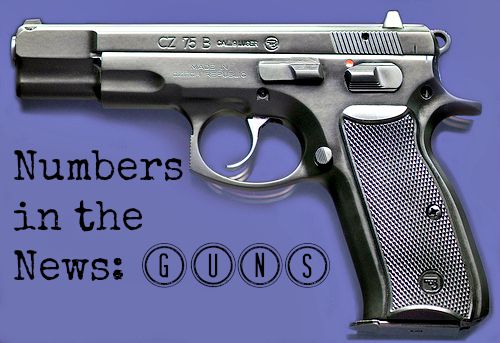This is the first of a series of posts looking at the numbers underlying hot topics in the U.S. The goal of this series is not to take a political or moral stand but to simply outline reliable data about these issues. Look for these posts to appear monthly.
I grew up in a hunting community. On the first day of deer season, students could take an excused absence, as long as they had a note from home that stated they were out hunting.
My 15-year-old daughter enjoys target shooting. Her favorite gun is a semi-automatic.
But despite my background, I have never fired a gun. I admit freely that I don’t particularly like them. At the same time, I have respect for those who hunt and use guns for sport, like target practice. And I respect the professionals in law enforcement who carry weapons in order to keep us safe.
Those are the disclaimers, as I step carefully into this loaded topic (pardon the pun). As a journalist who writes about math, I believe that numbers can help us understand these complex and controversial topics. With that said, I want to break down some of the numbers that describe our country’s relationship with guns.
This is something that anyone who consumes news reports or reacts to current events should be able to do. It’s a grownup skill that requires a little bit of math and a lot of logic. Because of the controversy involved in gun ownership and shooting incidents, it’s a good idea to turn to the numbers. So here we go.
The Small Arms Survey estimates that there are approximately 270 million guns owned by civilians in the U.S.
No one can say for sure that this number is absolutely correct. That’s because there is no way to definitively count the number of civilian-owned guns. There are several reasons for this. First, gun registrations is managed on a state-by-state basis. In fact, eight states explicitly prohibit the registration of firearms (though many have exceptions that require, for example, registration of a firearm by someone who was convicted of a crime). Without registering guns, it’s difficult to count them. Second, notice of the sale or transfer of guns is not required by all states. And stolen or lost guns? These may or may not be reported either.
If we can’t count the number of guns owned by Americans, we certainly have difficulty counting the types of guns in legal circulation. And never mind the number of illegally possessed firearms.
Still 270 million is generally recognized as the best estimate. And no one can deny that this is a large number. This is when we start comparing ourselves to other countries. India comes in second place with 46 million civilian-owned guns. Then China (40 million), Germany (25 million) and Pakistan (18 million). And while these numbers may be interesting, they don’t tell the whole story. Math helps with that.
Take the U.S. and India for example. The U.S. has a lot of guns, and India has a lot of people. So it’s useful to consider the number of guns per 100 people. (Or it could be per person or per 10 people… whatever.) In the U.S. there are 88 firearms per 100 men, women and children. In India, there are 4. Yes, four. Because India’s population is so much larger than the U.S.’s, the rate of guns per 100 people is much lower.
This brings in another interesting comparison: the U.S. and Yemen. In Yemen, there are approximately 11.5 million civilian-owned guns, but there are 55 guns per person. Small population + lots of guns = high rate of guns per person. In fact, the U.S. has more guns per 100 people than any other country in the world. (Yemen comes in second place.)
Now none of this says that guns are good or bad. These are just numbers. But it does point to differences in how countries (and the people in them) think about guns. This is definitely something worth looking into. But for now, let’s consider another number.
In 2013, the CDC reported 33,636 firearm deaths in the U.S.
Again, that’s a big number. It includes all sorts of deaths, including homicides, suicides and accidental deaths. What is often overlooked is the extremely high rate for suicide by firearm. Nearly 2/3 of all firearms deaths were suicides in 2013–that’s 21,175. There were 11,208 homicides by firearms in 2013, just about half the number of suicides. That leaves 1,253 deaths that were accidental or unclassified firearm deaths.
It might also be helpful to break down this really big number.
In 2013, firearms were responsible for about 92 deaths per day. That’s nearly 4 people per hour.
Suddenly those numbers are a whole lot more striking. There aren’t even four people in my immediate family! It’s important to remember that this total number includes both suicides and homicides.
Yet when we enter into a discussion about gun control, many of us think about homicides — and specifically mass shootings. According to the FBI, there were 17 “active shooter incidents” in 2013. In those incidents, 44 people died and 42 people were injured. That’s a lot of people and a lot of scary moments. At the same time, compare those numbers with the number of suicides by firearms. That’s a big difference.
Guns were responsible for more than half of all suicides in 2013 in the U.S..
That year, 41,149 people committed suicide, and as stated above, 21,175 of them chose to end their lives using a firearm. So it seems that the best way to reduce suicides and the number of gun deaths is to reduce the number of suicides by guns. Two birds, one stone.
Certainly better mental health care is a good option. But there is something even easier. In Great Britain in the 1950s and 60s, about half of all suicides were by coal gas from ovens. But by the 1970s, coal gas was replaced by natural gas, which has far less carbon monoxide. The suicide rate by gas had dropped to zero (yes, zero) and the overall suicide rate had fallen by a third.
These are striking numbers that suggest that when the means of suicide is eliminated, the suicide rate drops. What would happen in this country, if suicidal folks did not have access to guns?
In my mind, this leads to a logical conclusion: gun control is a matter of public health. I don’t believe that we should rid our country of civilian-owned firearms or outlaw the possibility of owning guns. I do believe that to reduce the incidence of death by firearms, we can develop safety measures. These will likely include a variety of approaches–much like how we ensure that cars are as safe as possible.
How did I come to that conclusion? The numbers told me so.
What are your thoughts on the numbers behind the gun control debate? Were any of these figures surprising to you? (NOTE: This is a very volatile subject, so I ask that you please keep your comments civil and on point.)








Comments are closed.